Articles
- Page Path
- HOME > J Korean Acad Nurs > Volume 44(3); 2014 > Article
-
Original Article
- Development of Reproductive Health Program and Identification of Effect for Married Women Immigrants
- Myeong Nam Park, So Young Choi
-
Journal of Korean Academy of Nursing 2014;44(3):248-258.
DOI: https://doi.org/10.4040/jkan.2014.44.3.248
Published online: June 30, 2014
1Department of Nursing, Jinju Health College, Jinju, Korea.
2College of Nursing, Institute of Health Science, Gyeongsang National University, Jinju, Korea.
- Address reprint requests to: Choi, So Young. College of Nursing, Institute of Health Science, Gyeongsang National University, 816-15 Jnju-daero, Jinju 660-751, Korea. Tel: +82-55-772-8241, Fax: +82-55-772-8209, csy4214@hanmail.net
© 2014 Korean Society of Nursing Science
This is an Open Access article distributed under the terms of the Creative Commons Attribution NoDerivs License. (http://creativecommons.org/licenses/by-nd/4.0/) If the original work is properly cited and retained without any modification or reproduction, it can be used and re-distributed in any format and medium.
Abstract
-
Purpose
- This study was done to develop a reproductive health program to improve reproductive health of women immigrants.
-
Methods
- The participants in the study were 58 immigrant women who lived in Vietnam, China, Philippines, or Cambodia before marriage. They were assigned to the experiment group (n=29) or the control group (n=29). The reproductive health program for this study consisted of reproductive health education, health counseling, phone monitoring, and emotional support based on Cox (1982)'s Interaction Model of Client Health Behavior and was implemented for four weeks.
-
Results
- There were significant differences in reproductive health knowledge (t=9.78, p<.001), reproductive health attitude (t=6.59, p<.001), and reproductive health behavior (t=5.11, p<.001) within and between groups after the reproductive health program. But there were no significant differences in clinical indicators between the two groups.
-
Conclusion
- The results of this study indicate the that reproductive health program for the women immigrants is effective in terms of reproductive health knowledge, reproductive health attitude and reproductive health behaviors. Therefore, nurses in public and private facilities, such as multicultural centers and public health centers in each community, should develop strategies to expand and provide reproductive health programs for women immigrants.
This manuscript is based on a part of the first author's doctoral dissertation from Gyeongsang National University.
- 1. Statistics Korea. Annual report on the marriages and divorces statistics: Based on vital registration. Daejeon: Author; 2013.
- 2. Ministry of Security and Public Administration. Statistics on foreign residents by local governments in 2012 [Internet]. Seoul, Author. 2012;cited 2013 July 6. Available from: www.mospa.go.kr/frt/bbs/type001/commonSelectBoardArticledo?bbsId=BBSMSTR_000000000014&nttId=35593.
- 3. Kim GS, Moon SS. Perceived health status, health behavior, and marital satisfaction in married immigrant women. J Korean Acad Public Health Nurs. 2011;25(2):174–186.
- 4. Kim HJ, Sim MJ, Oh HS. The knowledge of menstruation, attitude for menstruation, and knowledge of contraception for immigrant women in international marriages. J Digit Policy Manage. 2012;10(5):307–314.
- 5. The International Conference on Population and Development. Programme of action of the international conference on population and development. Chapter VII: Reproductive rights and reproductive health [Internet]. Cairo, EG, Author. 1994;cited 2013 July 6. Available from: http://www.unfpa.org/icpd/icpd-programme.cfm#ch7
- 6. Choi SY, Park MN. Knowledge about cervical cancer and health beliefs on HPV vaccination in immigrant women. J Korean Data Anal Soc. 2012;14(3):1399–1410.
- 7. Jeon MS, Kang KJ, Park SH. A study on pregnancy, delivery, and infant rearing knowledge and educational need of marriage immigrant women. J Agric Med Community Health. 2011;36(3):179–190. http://dx.doi.org/10.5393/JAMCH.2011.36.3.179Article
- 8. Seol DH, Kim YT, Kim HM, Yoon HS, Lee HK, Yim KT, et al. Foreign wives' life in Korea: Focusing on the policy of welfare and health. Gwacheon: Ministry of Health & Welfare; 2005.
- 9. Kim HR, Hwang NM, Jang IS, Yun KJ, Kang BJ. Reproductive health status of women marriage immigrants in Korea and policy directions. Seoul: Korea Institute for Health and Social Affairs; 2008.Report No.: Policy Paper 2008-66.
- 10. Kim HJ. A study of spousal support, the demand for health education, and quality of life for married female immigrants. Korean J Women Health Nurs. 2008;14(1):5–11.ArticlePDF
- 11. Jang IS, Hwang NM, Yoon MS, Park S. Current status and factors affecting prenatal care by married immigrant women. Korean J Women Health Nurs. 2010;16(4):326–335. http://dx.doi.org/10.4069/kjwhn.2010.16.4.326ArticlePubMed
- 12. Kim MJ, Kim TI, Kwon YJ. A study on health promotion behavior and contraception in married immigrant women. Korean J Women Health Nurs. 2008;14(4):323–332. http://dx.doi.org/10.4069/kjwhn.2008.14.4.323Article
- 13. Kim EH, Lee E, Kim MJ, Park DY, Lee SH. Effects of an educational program of pregnancy and delivery on pregnancy related knowledge, newborn care knowledge, and postpartum care self-efficacy of marriage immigrant women. J Korean Acad Nurs. 2010;40(1):78–87. http://dx.doi.org/10.4040/jkan.2010.40.1.78ArticlePubMed
- 14. Hyun KJ, Kim YS. Development of a Korean life adaptation measure for female marriage immigrants. Health Soc Welf Rev. 2011;31(4):63–100.Article
- 15. Cox CL. An interaction model of client health behavior: Theoretical prescription for nursing. ANS Adv Nurs Sci. 1982;5(1):41–56.PubMed
- 16. He D, Zhou Y, Ji N, Wu S, Wang Z, Decat P, et al. Study on sexual and reproductive health behaviors of unmarried female migrants in China. J Obstet Gynaecol Res. 2012;38(4):632–638. http://dx.doi.org/10.1111/j.1447-0756.2011.01753.xArticlePubMed
- 17. Wong LP. An exploration of knowledge, attitudes and behaviours of young multiethnic Muslim-majority society in Malaysia in relation to reproductive and premarital sexual practices. BMC Public Health. 2012;12:865. http://dx.doi.org/10.1186/1471-2458-12-865ArticlePubMedPMCPDF
- 18. Women's Health Nursing Learing Communities. Women's health nursing (I, II): Maternity nursing. 7th ed. Paju: Soomoonsa; 2012.
- 19. Kwag HS. Development and evaluation of health promotion program for the pre-hypertensive middle aged group [dissertation]. Daegu, Keimyung University. 2005.
- 20. Kim HJ. Effects of health promotion program for stroke patients at home [dissertation]. Daegu, Keimyung University. 2004.
- 21. Cohen J. A power primer. Psychol Bull. 1992;112(1):155–159.ArticlePubMed
- 22. Lee EJ, Park JS. Knowledge about cervical cancer, health beliefs and human papillomavirus vaccination rate in female university students. J Korean Oncol Nurs. 2011;11(1):65–73. http://dx.doi.org/10.5388/jkon.2011.11.1.65ArticlePDF
- 23. Lu C, Xu L, Wu J, Wang Z, Decat P, Zhang WH, et al. Sexual and reproductive health status and related knowledge among female migrant workers in Guangzhou, China: A cross-sectional survey. Eur J Obstet Gynecol Reprod Biol. 2012;160(1):60–65. http://dx.doi.org/10.1016/j.ejogrb.2011.10.001ArticlePubMed
- 24. Ahn S, Park I, Han JS, Kim TI, Kwak MS, Chung HS. Health behaviors, reproductive health history, and sexual behaviors of college students. Korean J Women Health Nurs. 2008;14(3):205–212.ArticlePDF
- 25. Lee GM, Choi YH. Effects of newborn care education program on child-rearing knowledge, child-rearing stress, and child-rearing self-efficacy of immigrant pregnant women. J Korean Acad Public Health Nurs. 2012;26(3):561–571. http://dx.doi.org/10.5932/JKPHN.2012.26.3.561Article
- 26. Chung C, Lee S, Hwang S, Park E. Systematic review of exercise effects on health outcomes in women with breast cancer. Asian Nurs Res. 2013;7(3):149–159.Article
- 27. Jeon Y, Lee H. The effect of sex education program on high school girls' knowledge and attitude toward sex. J Korean Living Sci Assoc. 2007;16(6):1251–1268. http://dx.doi.org/10.5934/KJHE.2007.16.6.1251Article
- 28. Shin KR, Park HJ, Hong CM. Effects of an educational program about reproductive health promotion on sexual knowledge and attitudes of university students from Korea. J Korean Acad Adult Nurs. 2010;22(4):448–456.
- 29. Kim JH, Park MK. Effects of preventive sexual education of HPV on HPV knowledge, cervical cancer preventive behaviors, and sexual autonomy in female university students. J Korean Acad Soc Nurs Educ. 2010;16(2):257–264.Article
- 30. Farnam F, Pakgohar M, Mirmohamadali M, Mahmoodi M. Effect of sexual education on sexual health in Iran. Sex Educ. 2008;8(2):159–168. http://dx.doi.org/10.1080/14681810801981043Article
REFERENCES
Figure & Data
REFERENCES
Citations

- Development and evaluation of a quasi-experimental sexual and reproductive health literacy (SRHL) programme for marriage immigrants in South Korea: focus on Vietnamese women
Heeran Chun, Young Sook Lee, Hyeran Yoon
BMJ Public Health.2025; 3(2): e002473. CrossRef - The impact of reproductive health knowledge, reproductive health-promoting behavior, and sexual communication on intention to visit obstetrics and gynecology in unmarried women: a cross-sectional study
Da-In Kang, Euna Park
Women's Health Nursing.2024; 30(4): 309. CrossRef - The effectiveness of a tailored programme to promote reproductive‐health‐promoting behaviour in young women based on the Precaution Adoption Process Model: A randomized controlled trial
Inhae Cho, Young‐Joo Park
Nursing Open.2023; 10(3): 1704. CrossRef - Do family values and reproductive health knowledge influence reproductive health-promoting behaviors in married women? A cross-sectional survey
Sun Jeong Yun, Hye Young Kim
Korean Journal of Women Health Nursing.2022; 28(4): 286. CrossRef - The influence of eHealth literacy, reproductive health knowledge, and self-esteem on health-promoting behaviors in early adult women: a cross-sectional survey
Hye Sook Shin, Young A Song
Korean Journal of Women Health Nursing.2022; 28(4): 329. CrossRef - Cancer Screening Program Delivered by Community Health Workers for Chinese Married Immigrant Women in Korea
Jiyun Kim, Yuna Paik, Seungmi Park
International Journal of Environmental Research and Public Health.2022; 19(11): 6655. CrossRef - Effects of a Lifestyle Intervention on Health-Promoting Behavior, Psychological Distress and Reproductive Health of Overweight and Obese Female College Students
Ju-Hee Nho, Soo-Wan Chae
Healthcare.2021; 9(3): 309. CrossRef - Intervention for Married Immigrant Women in Korea: A Systematic Review
Soo Jin Lee, Xianglan Jin, Sujin Lee
Journal of The Korean Society of Maternal and Child Health.2021; 25(2): 99. CrossRef - Theoretical evaluation of Cox’s interaction model of client health behavior for health promotion in adult
women
Youlim Kim, Hyeonkyeong Lee, Gi Wook Ryu
Korean Journal of Women Health Nursing.2020; 26(2): 120. CrossRef - Gender Differences and Relationships among Lifestyle and Reproductive Health in University Students
Ju-Hee Nho, Hee Sun Kim
Korean Journal of Women Health Nursing.2019; 25(4): 446. CrossRef - A mobile video intervention for women’s health of North Korean defectors
Min Kyeong Lee, Gisoo Shin
Public Health Nursing.2018; 35(6): 558. CrossRef - Relationships among Lifestyle, Depression, Anxiety, and Reproductive Health in Female University Students
Ju-Hee Nho, Sung-Hee Yoo
Korean Journal of Women Health Nursing.2018; 24(1): 80. CrossRef - Factors influencing use of family planning in women living in crisis affected areas of Sub-Saharan Africa: A review of the literature
Kelly Ackerson, Ruth Zielinski
Midwifery.2017; 54: 35. CrossRef - The Lived Experiences of Clinical Nurses Who working at the Women's Hospital Caring for Foreign Wives in Korea: A Narrative Study Approach
Bongsook Yih
Journal of the Korea Academia-Industrial cooperation Society.2016; 17(1): 188. CrossRef - Influencing Factors of Intention to Receive Pap Tests in Vietnamese Women who Immigrated to Taiwan for Marriage
Fang-Hsin Lee, Hsiu-Hung Wang, Yung-Mei Yang, Joh-Jong Huang, Hsiu-Min Tsai
Asian Nursing Research.2016; 10(3): 189. CrossRef - Effects of a Customized Birth Control Program for Married Immigrant Postpartum Mothers
So Young Kim, So Young Choi
Journal of Korean Academy of Nursing.2016; 46(6): 780. CrossRef - Analysis of Health Related Intervention Research for Married Immigrant Women
Hyun-mi Ahn, Mi-ok Kim
Journal of Digital Convergence.2016; 14(12): 245. CrossRef - Effects of Web-based Preconception Health Promotion Program for Couples about to be Married
Nam Joo Je, So Young Choi
Journal of Korean Academy of Nursing.2016; 46(5): 720. CrossRef - Development and Application of a Health Promotion Program for Marriage Immigrant Women
In Ju Seo, Jeong Sook Park
Korean Journal of Adult Nursing.2015; 27(2): 198. CrossRef - Effects of Lifestyle Intervention on Fatigue, Nutritional Status and Quality of Life in Patients with Gynecologic Cancer
Hyunjin An, Ju-Hee Nho, Sunyoung Yoo, Hyunmin Kim, Minji Nho, Hojeong Yoo
Journal of Korean Academy of Nursing.2015; 45(6): 812. CrossRef
Homogeneity Test of General Characteristics (N=58)
*Fisher's exact probability test; Exp.=Experimental group; Cont.=Control group.
Homogeneity Test of Reproductive Health Related Characteristics (N=58)
*Fisher's exact probability test; Exp.=Experimental group; Cont.=Control group; HPV=Human papilloma virus; Pap=Papanicolaou; BMI=Body mass index.
Homogeneity of Dependent Variables (N=58)
Exp.=Experimental group; Cont.=Control group; STD=Sexual transmitted disease; RBC=Red blood cell; WBC=White blood cell; Hb=Hemoglobin; Hct=Hematocrit.
Comparison of reproductive Health Knowledge, Reproductive Health Attitude, Reproductive Health Behavior among the Two Groups after Reproductive Health Program (N=58)
Exp.=Experimental group; Cont.=Control group; RS=reproductive system; STD=Sexual transmitted disease.
Comparison of Results of Clinical Indicators for Two Groups after Program (N=58)
Exp.=Experimental group; Cont.=Control group; RBC=Red blood cell; WBC=White blood cell; Hb=Hemoglobin; Hct=Hematocrit.
*Fisher's exact probability test; Exp.=Experimental group; Cont.=Control group.
*Fisher's exact probability test; Exp.=Experimental group; Cont.=Control group; HPV=Human papilloma virus; Pap=Papanicolaou; BMI=Body mass index.
Exp.=Experimental group; Cont.=Control group; STD=Sexual transmitted disease; RBC=Red blood cell; WBC=White blood cell; Hb=Hemoglobin; Hct=Hematocrit.
Exp.=Experimental group; Cont.=Control group; RS=reproductive system; STD=Sexual transmitted disease.
Exp.=Experimental group; Cont.=Control group; RBC=Red blood cell; WBC=White blood cell; Hb=Hemoglobin; Hct=Hematocrit.
 KSNS
KSNS
 E-SUBMISSION
E-SUBMISSION
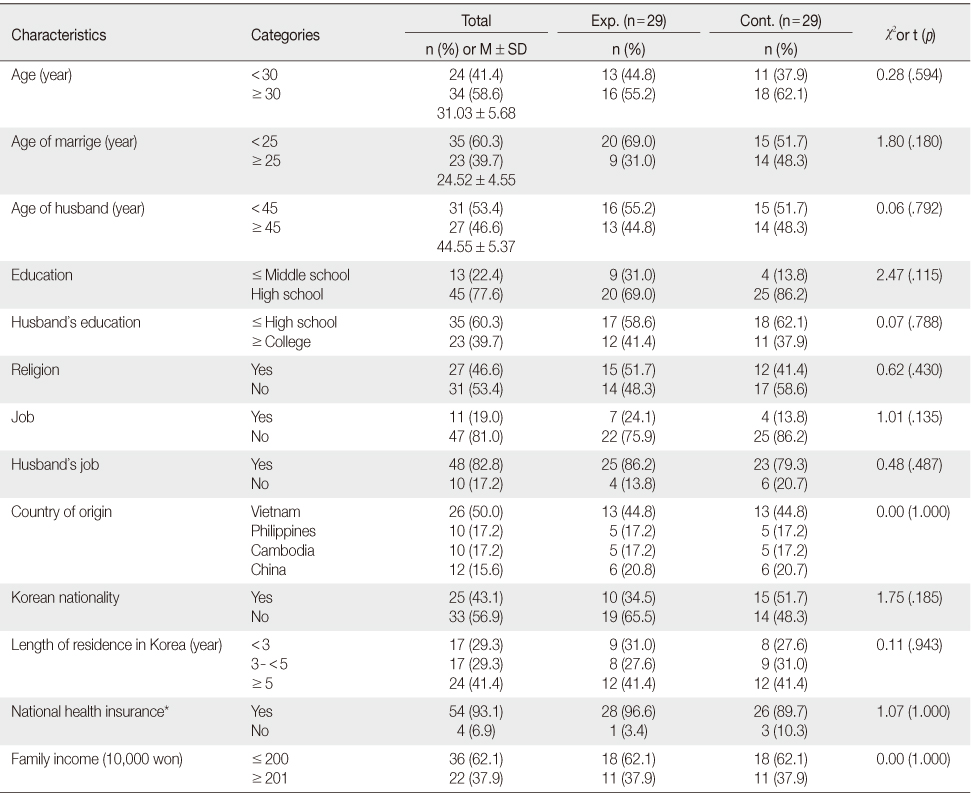
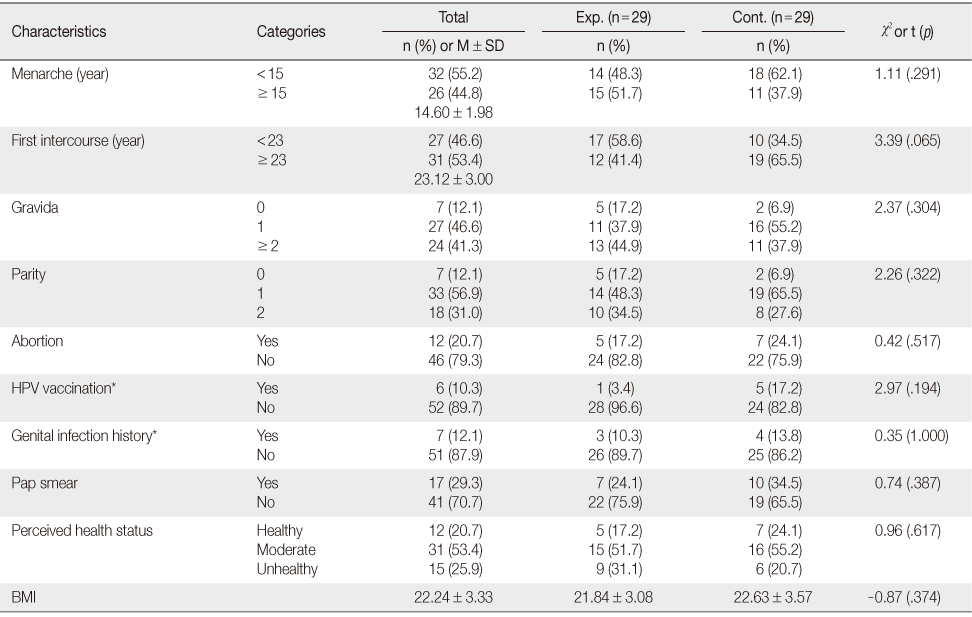
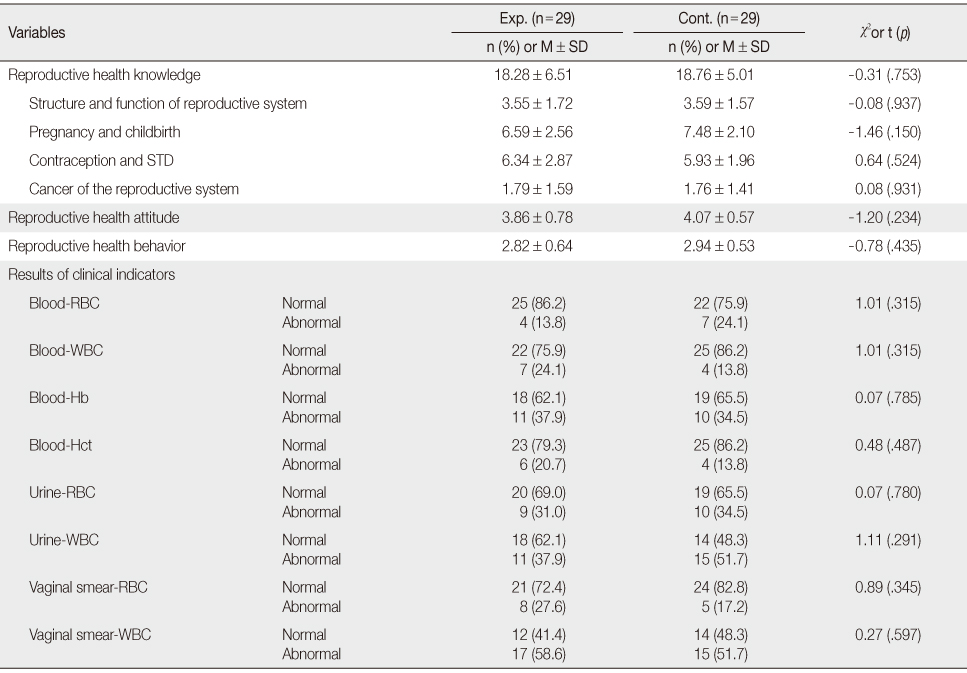
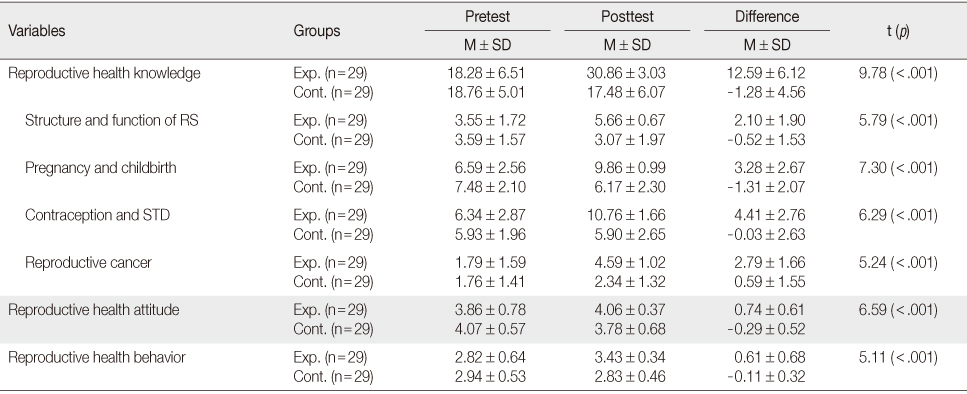
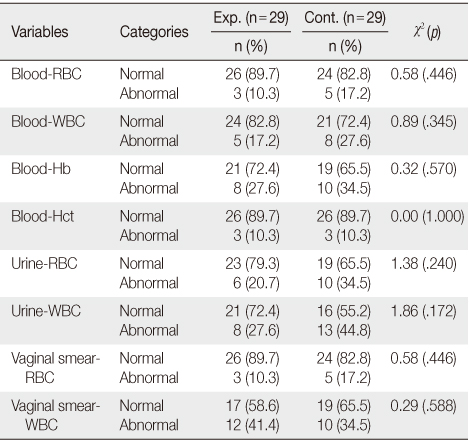
 Cite
Cite

